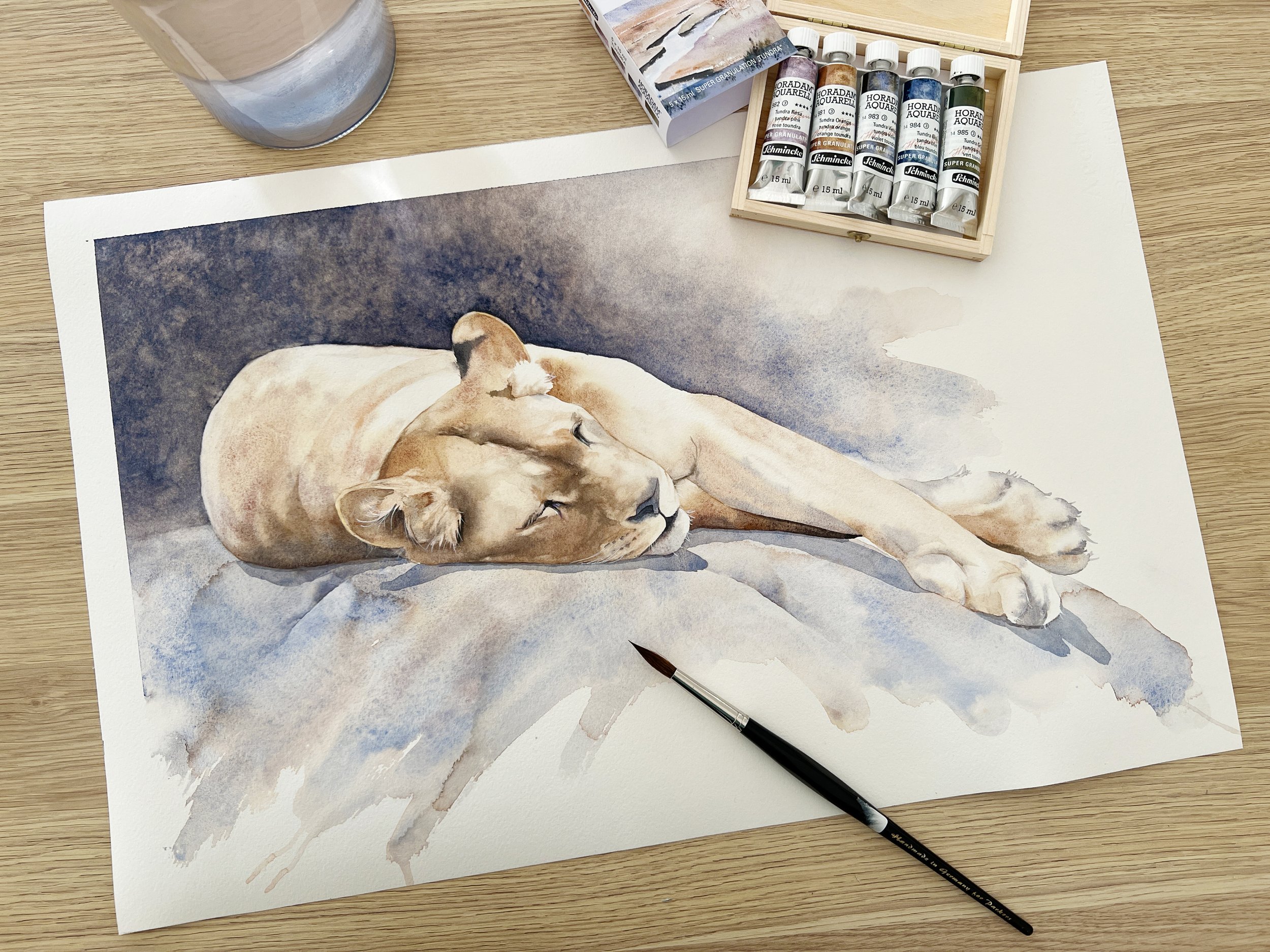What are Granulating Paints?
In simple terms, granulating paints contain pigments that separate and settle into particles as they dry. These particles create a textured or grainy appearance on the paper, adding distinct visual interest to a painting.
The granulating effect occurs because the pigments used in granulating paints have different densities or particle sizes. As the paint dries, the heavier or larger particles settle in the tooth of the paper, while the lighter or smaller particles remain on the surface, resulting in a granular or speckled pattern. It’s important to note that the effect of the granulation works best on wet paper.
How can you tell if a watercolour pigment is granulating?
The easiest way to tell whether a watercolour pigment is granulating is to look at a colour chart of the paints you use. Paint manufacturers indicate on their charts whether a pigment is granulating or not. You can buy the charts or you can go online and download them from the paint manufacturer's website.
Both Schmincke and Winsor & Newton label their pigments that are granulating with a ‘G’ for Granulation.
Daniel Smith labels the pigments that are granulating with a ‘Y’ for Yes (they are granulating) or ‘N’ for No (they aren’t granulating).
Keep in mind that the degree of granulation can vary among different brands or even within the same pigment from different manufacturers. It's always helpful to consult the manufacturer's information or reviews from other artists to get a more accurate understanding of a specific pigment's granulating behaviour.
What are some typical granulating pigments?
French Ultramarine (one of my favourite blues) is a popular granulating pigment that produces beautiful granulation patterns when it dries. It can range from subtle granulation to more pronounced texture, depending on the specific brand and quality.
Viridian is another pigment known for its granulating properties. It is a cool green pigment that can create interesting textures and variations when applied. I don’t use this pigment often but it is useful for mixing.
Cerulean Blue is a versatile pigment that can show granulation to varying degrees. It often creates a soft and subtle granulating effect when used in watercolour painting.
Raw Umber, an earth-tone pigment, often granulates beautifully, creating a natural and earthy texture in watercolour paintings.
What do you use granulating paints for?
Granulating paints can be particularly useful when depicting subjects with prominent textures, because they can help enhance the textural elements in your painting.
Granulating paints can help enhance subjects such as:
Landscapes: Rocky mountains, rugged terrains, or a weathered coastline
Architectural details: old brick walls, crumbling facades, or textured stonework
Natural elements: tree bark, foliage, grass, or the fur of animals
Textured objects: woven fabrics, weathered wood, or intricate patterns
Tips for using granulating paints
Different watercolour papers have varying textures, which can affect the granulation of your paints. Rough and cold-pressed papers tend to enhance granulation, while hot-pressed papers may result in less pronounced granulation. Try out different papers to find the texture that works best for you.
Granulation is enhanced when you work on wet paper.
Mix two granulating colours together for extra granulation.
Schmincke Super Granulating Paints
The renowned German paint manufacturer, 'Schmincke,' has recently introduced an impressive collection of 40 new watercolour paints renowned for their superb granulating properties. These paints can be obtained individually or in a selection of 8 themed sets, each containing five captivating colours. The sets include Deep Sea, Desert, Galaxy, Glacier, Forest, Shire, Tundra, and Volcano, all offering a unique and evocative palette.
Each colour within this range comprises a careful blend of at least two granulating pigments, ensuring an exceptional granulating effect. When applied to wet paper, these paints create stunning hue separation.
Maggie and Franz from Jackson’s in Australia were kind enough to send me the Tundra set to try.
The Tundra set features earthy and natural colours inspired by the Arctic landscape. Although this set is intended for landscape painting, I decided to use these granulating colours to paint a lioness relaxing on a sunlit rock. The textures created by the granulating paints added depth to the lioness's fur and made the artwork more captivating, even though it wasn't a typical Arctic scene.
Colours included in the Tundra set
I used three of the colours from the set, Tundra Orange, pink and violet and I particularly love the way the violet separated on the rock giving me two distinct colours and look at that gorgeous granulation that has provided the texture I needed.
Exploring the world of granulating watercolour paints is really useful if you are seeking to add depth and texture to your artwork. So, whether you're a landscape painter or find inspiration in unexpected subjects like a lioness basking in the sun, the world of granulating watercolour paints invites you to unleash your creativity and elevate your artistic expressions with captivating textures and exciting results!
If you are interested in learning to paint in watercolour, I have over 160 online, voiced over watercolour tutorials for all skill levels.
The lioness is available to purchase as a print in the shop.
Further reading: 9 Watercolour Texture Techniques








